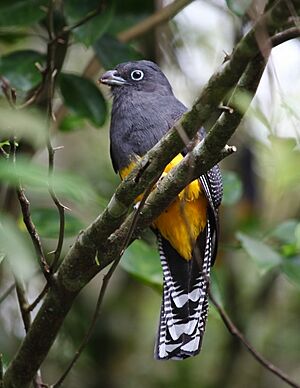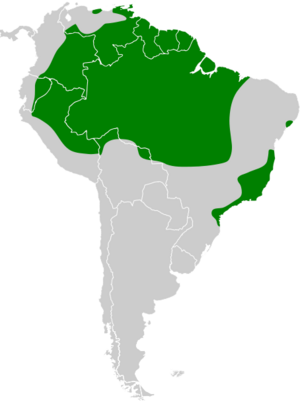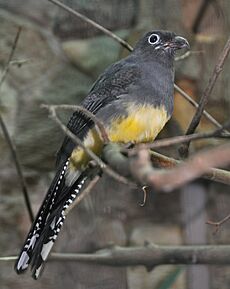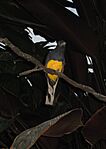Amazonian white-tailed trogon facts for kids
Quick facts for kids Amazonian white-tailed trogon |
|
|---|---|
 |
|
| A male green-backed trogon in Bertioga, São Paulo State, Brazil | |
 |
|
| A female green-backed trogon in Bertioga, São Paulo State, Brazil | |
| Conservation status | |
| Scientific classification | |
| Genus: |
Trogon
|
| Species: |
viridis
|
 |
|
| Synonyms | |
|
Trogon strigilatus |
|
The green-backed trogon (Trogon viridis), also known as the Amazonian white-tailed trogon, is a beautiful bird from the Trogonidae family. You can find it in many parts of the Amazon rainforest. There's also a separate group of them living on the southeast coast of Brazil.
Like all trogons, the male and female green-backed trogons look different. The male has a bright yellow belly and a blue head with a light blue ring around its eye. Its back is green, and its tail is mostly white underneath. The female is not as colorful. She has a dark grey head and back, with some black stripes under her tail.
About Its Name
The green-backed trogon got its official name from a Swedish scientist named Carl Linnaeus in 1766. He named it Trogon viridis. The word viridis is Latin for "green," which makes sense because of its green back!
For a while, this bird and another one, the white-tailed trogon (T. chionurus), were thought to be the same species. But in 2008, scientists studied their DNA. They found that the white-tailed trogon was actually more closely related to Baird's trogon. Because of this, and how their feathers looked different, they were officially separated into two different species. The bird we're talking about kept the name "green-backed trogon."
What It Looks Like
This trogon is a fairly large bird, about 28 to 30 centimeters (11 to 12 inches) long.
- Males: The male green-backed trogon has a dark blue head and upper chest. Its back is a bright green. The lower part of its belly is orange-yellow. Its wings are black with white patterns. The feathers under its tail are black at the base and white at the tips, making them look black and white. It also has a pale blue ring around its eye.
- Females: The female looks similar but is less colorful. She has a grey back, head, and chest. The feathers under her tail have clear black and white stripes.
You might confuse it with the violaceous trogon, but that bird is smaller. The male violaceous trogon has a yellow eye-ring, and the female has an incomplete white eye-ring.
The green-backed trogon's song sounds like about 20 "cow" notes. It starts slowly and then gets faster towards the end.
Where It Lives
You can find the green-backed trogon in warm, wet forests in South America. This includes the huge Amazon rainforest, the Guiana Shield area, the island of Trinidad, and the Atlantic Forest in eastern Brazil. It usually lives in tropical forests and is often the most common type of trogon in these areas.
How It Behaves
Green-backed trogons often sit very still and upright on branches. Even though they can fly fast, they usually don't fly long distances. Their wide beaks and weak legs are perfect for their diet and living in trees.
They mostly eat small fruit. They also snack on arthropods (like insects) and small lizards, especially when fruit is harder to find during the dry season. They are one of the trogons that eat the most fruit. Because of this, you don't often see them joining large groups of different bird species looking for food.
Green-backed trogons build their nests inside termite nests or in holes in old, rotting trees. The female usually digs an upward-sloping tunnel that leads to a special room for the eggs. They mostly nest during the summer months (June to August). A female usually lays two or three white eggs. The parents sit on the eggs for about 16 to 17 days. After the chicks hatch, they stay in the nest for about two more weeks before they are ready to fly.
Gallery




